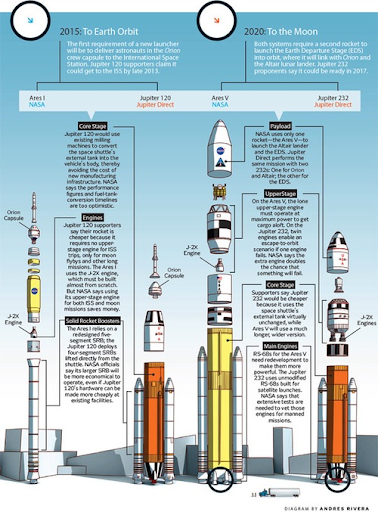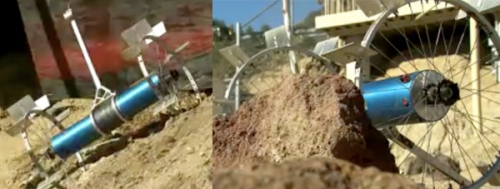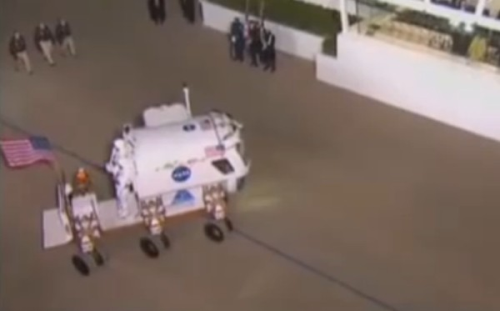 NASA, when it isn't finding rogue space lights or mysterious BOOMs of the non-Steve Jobsian variety, is apparently sending rogue science teams to brief President-elect Obama on the future of the space program. These teams weren't sanctioned by NASA top brass, so in a way they are effectively going rogue, not unlike an Alaskan governor in a Saks Fifth Avenue. They were also not towing the company line about the future of the space program. In fact, they argued that NASA should scrap the upcoming Ares rocket program in lieu of a new program called Jupiter Direct, which relies heavily on proven current-gen space shuttle program technologies and rocket parts.
NASA, when it isn't finding rogue space lights or mysterious BOOMs of the non-Steve Jobsian variety, is apparently sending rogue science teams to brief President-elect Obama on the future of the space program. These teams weren't sanctioned by NASA top brass, so in a way they are effectively going rogue, not unlike an Alaskan governor in a Saks Fifth Avenue. They were also not towing the company line about the future of the space program. In fact, they argued that NASA should scrap the upcoming Ares rocket program in lieu of a new program called Jupiter Direct, which relies heavily on proven current-gen space shuttle program technologies and rocket parts.  On paper at least, the Jupiter Direct program appears cheaper. Using a smaller and less cool-sounding rocket than the Ares 1, called the Jupiter 120, the program would require the modified external tank from the space shuttle, which would be shot into space by two RS-68 liquid-fuel engines. Liftoff would occur thanks to the two four-segment solid rocket boosters engineers would bring over directly from the existing shuttle program (which is obvious once you see that image). And better yet, the Jupiter Direct program has longevity built right in. Because its engine configuration is theoretically more powerful than Ares, the 120 rocket would have the extra oompf necessary for a lunar flyby. A larger Jupiter 232 rocket would allow man (and woman) to land on the moon after a hookup with NASA's Orion lander capsule, which the program leaves unchanged. Ultimately, the plan is about saving money and keeping space flight missions ongoing after the shuttle program is retired, not usurping NASA. The Obama transition team provided no comment on the rogue meeting, or on the Ares program, for that matter.
On paper at least, the Jupiter Direct program appears cheaper. Using a smaller and less cool-sounding rocket than the Ares 1, called the Jupiter 120, the program would require the modified external tank from the space shuttle, which would be shot into space by two RS-68 liquid-fuel engines. Liftoff would occur thanks to the two four-segment solid rocket boosters engineers would bring over directly from the existing shuttle program (which is obvious once you see that image). And better yet, the Jupiter Direct program has longevity built right in. Because its engine configuration is theoretically more powerful than Ares, the 120 rocket would have the extra oompf necessary for a lunar flyby. A larger Jupiter 232 rocket would allow man (and woman) to land on the moon after a hookup with NASA's Orion lander capsule, which the program leaves unchanged. Ultimately, the plan is about saving money and keeping space flight missions ongoing after the shuttle program is retired, not usurping NASA. The Obama transition team provided no comment on the rogue meeting, or on the Ares program, for that matter.
[ Via: Gizmodo, The Gadget Blog ]
 NASA's latest toy is is an oversized robotic yo-yo dubbed the Axel Rover. Developed in collaboration with Caltech, it's designed to to raise and lower itself over any environment with a motorized lever that can be used for tethering as well as scooping up materials for scientific research and maneuvering its two cameras. Two more motors run each of its wheels, which should ensure it's more than equipped to traverse anything from the Garden of Eden to otherworldly terrain right next door to Hell. Check out the rover doing its thing in the video after the break
NASA's latest toy is is an oversized robotic yo-yo dubbed the Axel Rover. Developed in collaboration with Caltech, it's designed to to raise and lower itself over any environment with a motorized lever that can be used for tethering as well as scooping up materials for scientific research and maneuvering its two cameras. Two more motors run each of its wheels, which should ensure it's more than equipped to traverse anything from the Garden of Eden to otherworldly terrain right next door to Hell. Check out the rover doing its thing in the video after the break
 GeoEye-1 took this satellite photo of Barack Obama's inauguration ceremony. At left, crowd. At right, Capitol Building.
GeoEye-1 took this satellite photo of Barack Obama's inauguration ceremony. At left, crowd. At right, Capitol Building. GeoEye-1 took this satellite photo of Barack Obama's inauguration ceremony. Note the shape of the crowd gathered around the large-screen TV in upper right.
GeoEye-1 took this satellite photo of Barack Obama's inauguration ceremony. Note the shape of the crowd gathered around the large-screen TV in upper right. GeoEye-1 took this satellite photo of the Mall during Barack Obama's inauguration ceremony. Click to see a larger image.
GeoEye-1 took this satellite photo of the Mall during Barack Obama's inauguration ceremony. Click to see a larger image. NASA, when it isn't finding rogue space lights or mysterious BOOMs of the non-Steve Jobsian variety, is apparently sending rogue science teams to brief President-elect Obama on the future of the space program. These teams weren't sanctioned by NASA top brass, so in a way they are effectively going rogue, not unlike an Alaskan governor in a Saks Fifth Avenue. They were also not towing the company line about the future of the space program. In fact, they argued that NASA should scrap the upcoming Ares rocket program in lieu of a new program called Jupiter Direct, which relies heavily on proven current-gen space shuttle program technologies and rocket parts.
NASA, when it isn't finding rogue space lights or mysterious BOOMs of the non-Steve Jobsian variety, is apparently sending rogue science teams to brief President-elect Obama on the future of the space program. These teams weren't sanctioned by NASA top brass, so in a way they are effectively going rogue, not unlike an Alaskan governor in a Saks Fifth Avenue. They were also not towing the company line about the future of the space program. In fact, they argued that NASA should scrap the upcoming Ares rocket program in lieu of a new program called Jupiter Direct, which relies heavily on proven current-gen space shuttle program technologies and rocket parts.  On paper at least, the Jupiter Direct program appears cheaper. Using a smaller and less cool-sounding rocket than the Ares 1, called the Jupiter 120, the program would require the modified external tank from the space shuttle, which would be shot into space by two RS-68 liquid-fuel engines. Liftoff would occur thanks to the two four-segment solid rocket boosters engineers would bring over directly from the existing shuttle program (which is obvious once you see that image). And better yet, the Jupiter Direct program has longevity built right in. Because its engine configuration is theoretically more powerful than Ares, the 120 rocket would have the extra oompf necessary for a lunar flyby. A larger Jupiter 232 rocket would allow man (and woman) to land on the moon after a hookup with NASA's Orion lander capsule, which the program leaves unchanged. Ultimately, the plan is about saving money and keeping space flight missions ongoing after the shuttle program is retired, not usurping NASA. The Obama transition team provided no comment on the rogue meeting, or on the Ares program, for that matter.
On paper at least, the Jupiter Direct program appears cheaper. Using a smaller and less cool-sounding rocket than the Ares 1, called the Jupiter 120, the program would require the modified external tank from the space shuttle, which would be shot into space by two RS-68 liquid-fuel engines. Liftoff would occur thanks to the two four-segment solid rocket boosters engineers would bring over directly from the existing shuttle program (which is obvious once you see that image). And better yet, the Jupiter Direct program has longevity built right in. Because its engine configuration is theoretically more powerful than Ares, the 120 rocket would have the extra oompf necessary for a lunar flyby. A larger Jupiter 232 rocket would allow man (and woman) to land on the moon after a hookup with NASA's Orion lander capsule, which the program leaves unchanged. Ultimately, the plan is about saving money and keeping space flight missions ongoing after the shuttle program is retired, not usurping NASA. The Obama transition team provided no comment on the rogue meeting, or on the Ares program, for that matter. 